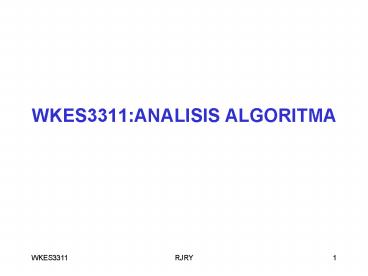WKES3311:ANALISIS ALGORITMA - PowerPoint PPT Presentation
1 / 23
Title:
WKES3311:ANALISIS ALGORITMA
Description:
To make statement we say: f(n) Worst / best/average ... EXAMPLE 1 ... For T(n) a non-negatively valued function, T(n) is in set (g(n)) if there exist two ... – PowerPoint PPT presentation
Number of Views:63
Avg rating:3.0/5.0
Title: WKES3311:ANALISIS ALGORITMA
1
WKES3311ANALISIS ALGORITMA
2
WHICH ALGORITHM?
- The higher growth rate?
- OR
- The lower growth rate?
3
ASYMPTOTIC ANALYSIS
- Refers to the study of an algorithm as the input
size gets big or reaches a limit - It has its limitation
4
ALGORITHM BEHAVIOUR
- Terms describing the running time equation for an
algorithm
5
UPPER BOUND O(f(n)) BIG OH
- The highest growth rate that an algorithm can
have - To make statement we say
Worst / best/average
f(n)
6
UPPER BOUND PRECISE STATEMENT
- For T(n) a non-negatively valued function, T(n)
is in set if there exist two positive
constants c and n0 such that for all n gt
n0
7
EXAMPLE 1
- Consider the sequential search algorithm for
finding a specific value in an array of integers
8
EXAMPLE 2
- For a particular algorithm, T(n) c1n2 c2n in
the average case where c1 and c2 are positive
numbers
9
LOWER BOUND ?(g(n)) BIG OMEGA DEFINITION
- For T(n) a non-negatively valued function, T(n)
is in set ?(g(n)) if there exist two - OR
- T(n) is in the set ?(g(n)) if there exists a
positive constant c such that
10
EXAMPLE 1
- Assume T(n)c1n2 c2n for c1 and c2 gt 0.
- So, T(n) ? c1n2 for c c1 and n01.
11
EXAMPLE 2
12
?(h(n)) THE BIG THETA
- When the upper and lower bound for an algorithm
are the same within a constant factor we indicate
this by using ?(big-Theta) notation.
13
EXAMPLE 1
- Sequential Search Algorithm
- So we say that this algorithm is both in O(n) and
?(n) OR JUST ?(n)
14
SIMPLIFYING RULES
- If f(n) is in
then f(n) is in O(h(n)) - If f(n) for any
constant kgt0, then f(n) is in O(g(n) - If f1(n) is in is in
O(g2(n)),
O(max(g1(n),g2(n))) - If f1(n) is in O(g1(n)) and f2(n) is in
- Rule also holds for ? and ? notations
15
CALCULATING THE RUNNING TIME
- Example 1
- Since the assignment statement takes constant
time, it is ?(1)
16
EXAMPLE 2
- sum 0
- for (i1iltni)
- sum n
17
EXAMPLE 3
- Asignment (sum0)
- Second loop
- First loop
- c3j(sum)
- Therefore its c3
- sum 0
- for (j1jltnj) //First for loop
- for (i1iltji)// is a double loop
- sum
- for (k0kltnk) // Second for loop
- Akk
- By rule(3),
18
EXAMPLE 4
- sum10
- for (k1kltnk2) // Do log n times
- for(j1jltnj) // Do n times
- sum
- sum20
- For(k1kltnk22) // Do log n times
- for(j1jltkj) // Do k times
- sum2
- simply
- simply
19
EXAMPLE 5
- Long fact (int n) //Compute n!
- //To fit n! in a long variable, require nlt12
- Assert((ngt0)(nlt12)), Input out of range)
- if (nlt1) return 1
- return n fact(n-1)
20
RECURRENCE RELATIONSHIP T(n)T(n-1) 1
- T(n) T(n-1)1
- (T(n-2)1)1, how can we write this in terms of
summation? - T(n-3)3 , therefore we conclude
- T(n) T(n-(n-1))
21
PROOF BY INDUCTION
- Theorem1 T(n) T(n-1) 1 T(1)0 has
closed-form solution T(n)n-1 - Proof To prove the base case we observe
22
SPACE BOUNDS
- The
to measure space are similar to those used to - Concepts of can also
be applied with
23
HOMEWORKS
- What are the space requirements for a two
dimensional array? - What are the space requirements for n Boolean
flags?































